clutch DODGE DART 2015 PF / 1.G Owners Manual
[x] Cancel search | Manufacturer: DODGE, Model Year: 2015, Model line: DART, Model: DODGE DART 2015 PF / 1.GPages: 664, PDF Size: 16.96 MB
Page 38 of 664
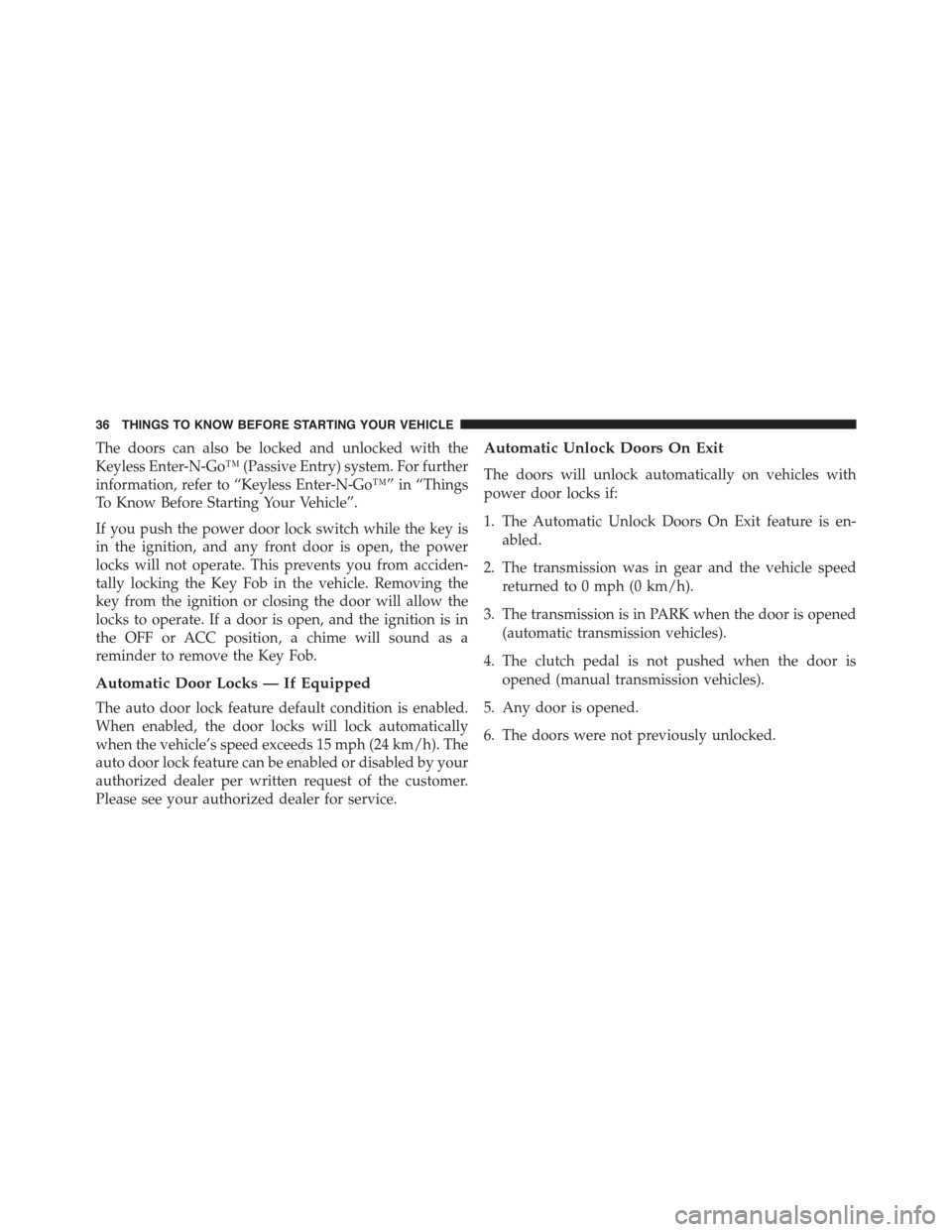
The doors can also be locked and unlocked with the
Keyless Enter-N-Go™ (Passive Entry) system. For further
information, refer to “Keyless Enter-N-Go™” in “Things
To Know Before Starting Your Vehicle”.
If you push the power door lock switch while the key is
in the ignition, and any front door is open, the power
locks will not operate. This prevents you from acciden-
tally locking the Key Fob in the vehicle. Removing the
key from the ignition or closing the door will allow the
locks to operate. If a door is open, and the ignition is in
the OFF or ACC position, a chime will sound as a
reminder to remove the Key Fob.
Automatic Door Locks — If Equipped
The auto door lock feature default condition is enabled.
When enabled, the door locks will lock automatically
when the vehicle’s speed exceeds 15 mph (24 km/h). The
auto door lock feature can be enabled or disabled by your
authorized dealer per written request of the customer.
Please see your authorized dealer for service.
Automatic Unlock Doors On Exit
The doors will unlock automatically on vehicles with
power door locks if:
1. The Automatic Unlock Doors On Exit feature is en-
abled.
2. The transmission was in gear and the vehicle speed
returned to 0 mph (0 km/h).
3. The transmission is in PARK when the door is opened
(automatic transmission vehicles).
4. The clutch pedal is not pushed when the door is
opened (manual transmission vehicles).
5. Any door is opened.
6. The doors were not previously unlocked.
36 THINGS TO KNOW BEFORE STARTING YOUR VEHICLE
Page 413 of 664
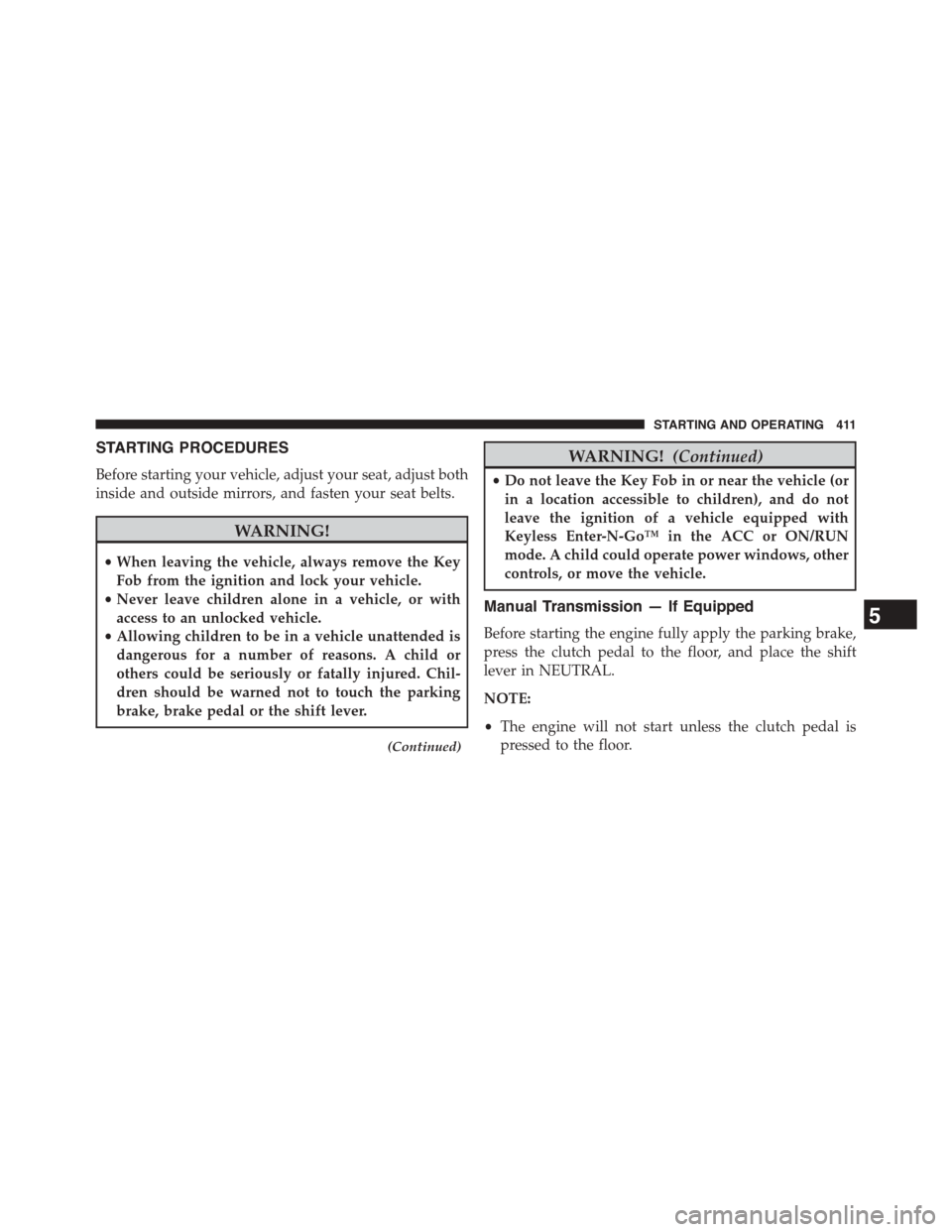
STARTING PROCEDURES
Before starting your vehicle, adjust your seat, adjust both
inside and outside mirrors, and fasten your seat belts.
WARNING!
•When leaving the vehicle, always remove the Key
Fob from the ignition and lock your vehicle.
•Never leave children alone in a vehicle, or with
access to an unlocked vehicle.
•Allowing children to be in a vehicle unattended is
dangerous for a number of reasons. A child or
others could be seriously or fatally injured. Chil-
dren should be warned not to touch the parking
brake, brake pedal or the shift lever.
(Continued)
WARNING!(Continued)
•Do not leave the Key Fob in or near the vehicle (or
in a location accessible to children), and do not
leave the ignition of a vehicle equipped with
Keyless Enter-N-Go™ in the ACC or ON/RUN
mode. A child could operate power windows, other
controls, or move the vehicle.
Manual Transmission — If Equipped
Before starting the engine fully apply the parking brake,
press the clutch pedal to the floor, and place the shift
lever in NEUTRAL.
NOTE:
•The engine will not start unless the clutch pedal is
pressed to the floor.
5
STARTING AND OPERATING 411
Page 420 of 664
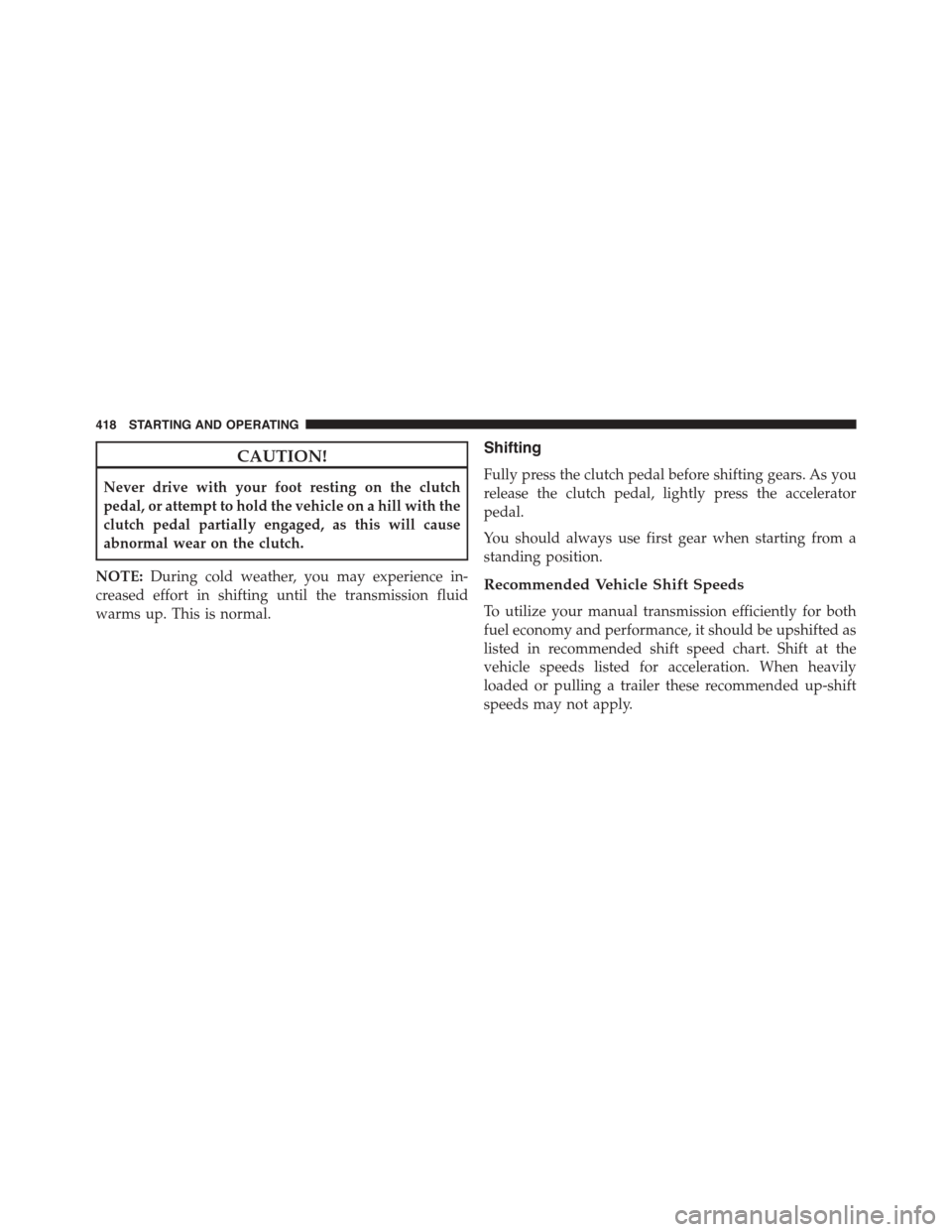
CAUTION!
Never drive with your foot resting on the clutch
pedal, or attempt to hold the vehicle on a hill with the
clutch pedal partially engaged, as this will cause
abnormal wear on the clutch.
NOTE:During cold weather, you may experience in-
creased effort in shifting until the transmission fluid
warms up. This is normal.
Shifting
Fully press the clutch pedal before shifting gears. As you
release the clutch pedal, lightly press the accelerator
pedal.
You should always use first gear when starting from a
standing position.
Recommended Vehicle Shift Speeds
To utilize your manual transmission efficiently for both
fuel economy and performance, it should be upshifted as
listed in recommended shift speed chart. Shift at the
vehicle speeds listed for acceleration. When heavily
loaded or pulling a trailer these recommended up-shift
speeds may not apply.
418 STARTING AND OPERATING
Page 421 of 664

Manual Transmission Shift Speeds in MPH (KM/H)
All Engines Gear Selection 2 to 33 to 44 to 55 to 6
Accel.24 (39)34 (55)47 (76)56 (90)
Cruise19 (31)27 (43)37 (60)41 (66)
Downshifting
Moving from a high gear down to a lower gear is
recommended to preserve brakes when driving down
steep hills. In addition, downshifting at the right time
provides better acceleration when you desire to resume
speed. Downshift progressively. Do not skip gears to
avoid overspeeding the engine and clutch.
WARNING!
Do not downshift for additional engine braking on a
slippery surface. The drive wheels could lose their
grip, and the vehicle could skid.
CAUTION!
•Skipping gears and downshifting into lower gears
at higher vehicle speeds can damage the engine
and clutch systems, Any attempt to shift into lower
gear with clutch pedal depressed may result dam-
age to the clutch system. Shifting into lower gear
and releasing the clutch may result in engine
damage.
(Continued)
5
STARTING AND OPERATING 419
Page 422 of 664
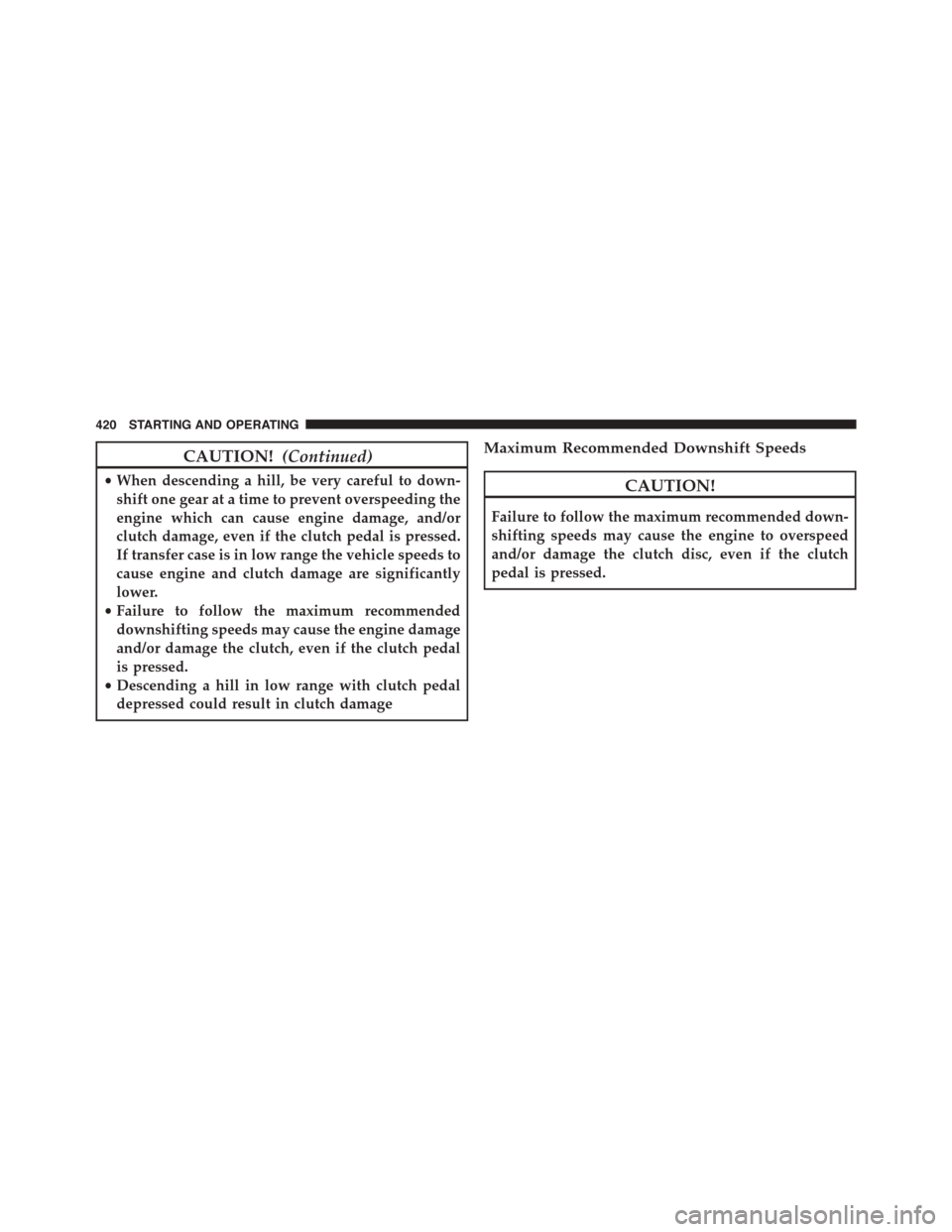
CAUTION!(Continued)
•When descending a hill, be very careful to down-
shift one gear at a time to prevent overspeeding the
engine which can cause engine damage, and/or
clutch damage, even if the clutch pedal is pressed.
If transfer case is in low range the vehicle speeds to
cause engine and clutch damage are significantly
lower.
•Failure to follow the maximum recommended
downshifting speeds may cause the engine damage
and/or damage the clutch, even if the clutch pedal
is pressed.
•Descending a hill in low range with clutch pedal
depressed could result in clutch damage
Maximum Recommended Downshift Speeds
CAUTION!
Failure to follow the maximum recommended down-
shifting speeds may cause the engine to overspeed
and/or damage the clutch disc, even if the clutch
pedal is pressed.
420 STARTING AND OPERATING
Page 423 of 664
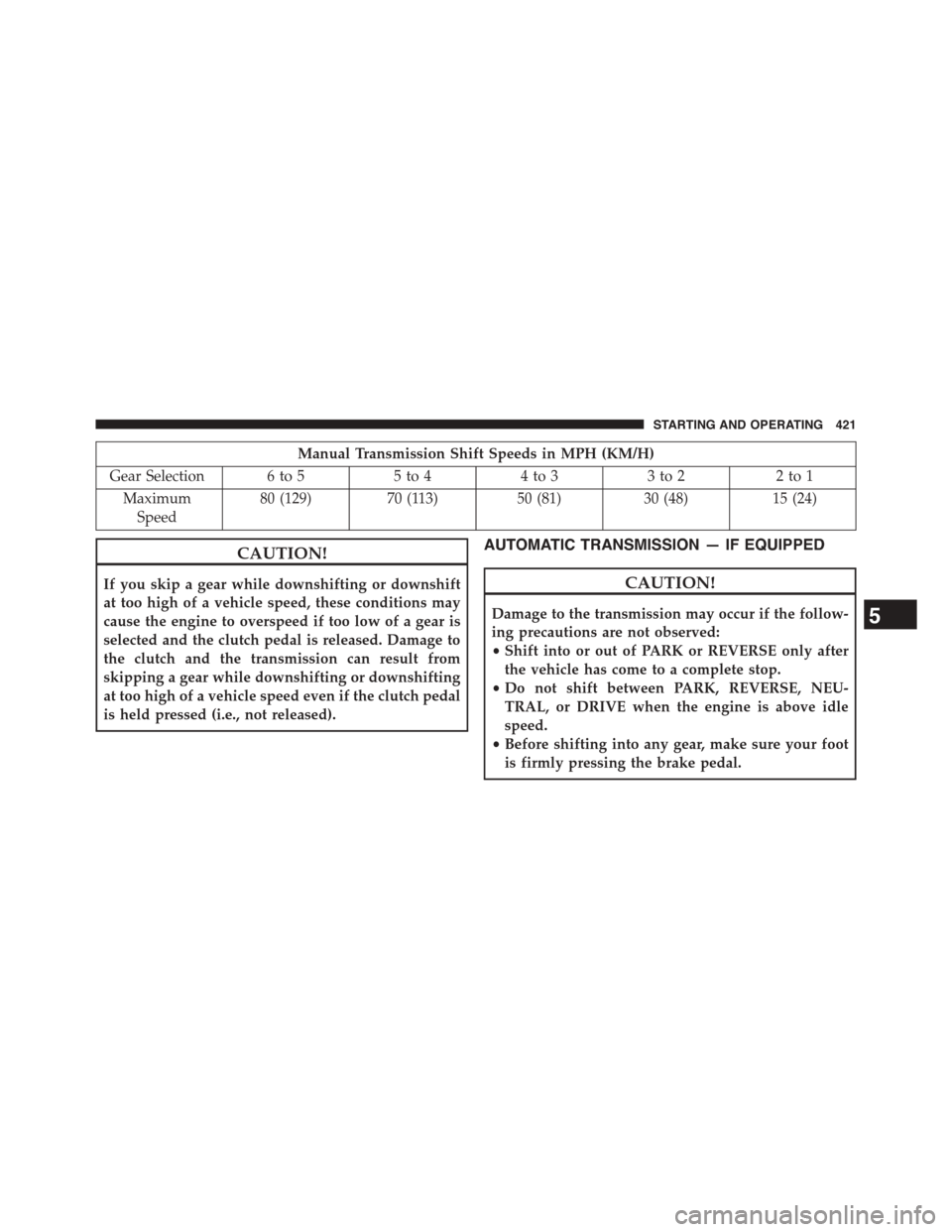
Manual Transmission Shift Speeds in MPH (KM/H)
Gear Selection 6 to 55 to 44 to 33 to 22 to 1
Maximum
Speed
80 (129)70 (113)50 (81)30 (48)15 (24)
CAUTION!
If you skip a gear while downshifting or downshift
at too high of a vehicle speed, these conditions may
cause the engine to overspeed if too low of a gear is
selected and the clutch pedal is released. Damage to
the clutch and the transmission can result from
skipping a gear while downshifting or downshifting
at too high of a vehicle speed even if the clutch pedal
is held pressed (i.e., not released).
AUTOMATIC TRANSMISSION — IF EQUIPPED
CAUTION!
Damage to the transmission may occur if the follow-
ing precautions are not observed:
•Shift into or out of PARK or REVERSE only after
the vehicle has come to a complete stop.
•Do not shift between PARK, REVERSE, NEU-
TRAL, or DRIVE when the engine is above idle
speed.
•Before shifting into any gear, make sure your foot
is firmly pressing the brake pedal.
5
STARTING AND OPERATING 421
Page 432 of 664
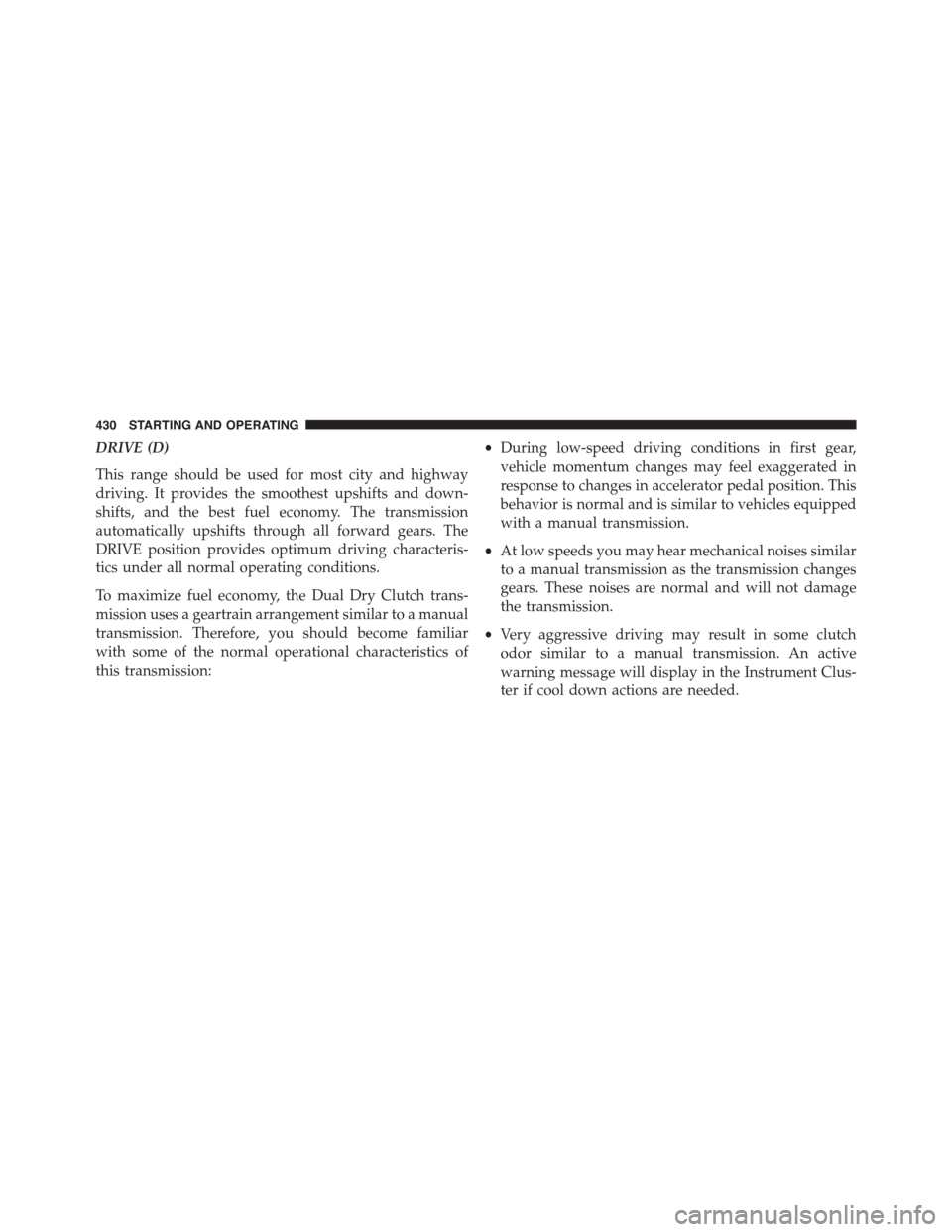
DRIVE (D)
This range should be used for most city and highway
driving. It provides the smoothest upshifts and down-
shifts, and the best fuel economy. The transmission
automatically upshifts through all forward gears. The
DRIVE position provides optimum driving characteris-
tics under all normal operating conditions.
To maximize fuel economy, the Dual Dry Clutch trans-
mission uses a geartrain arrangement similar to a manual
transmission. Therefore, you should become familiar
with some of the normal operational characteristics of
this transmission:
•During low-speed driving conditions in first gear,
vehicle momentum changes may feel exaggerated in
response to changes in accelerator pedal position. This
behavior is normal and is similar to vehicles equipped
with a manual transmission.
•At low speeds you may hear mechanical noises similar
to a manual transmission as the transmission changes
gears. These noises are normal and will not damage
the transmission.
•Very aggressive driving may result in some clutch
odor similar to a manual transmission. An active
warning message will display in the Instrument Clus-
ter if cool down actions are needed.
430 STARTING AND OPERATING
Page 435 of 664
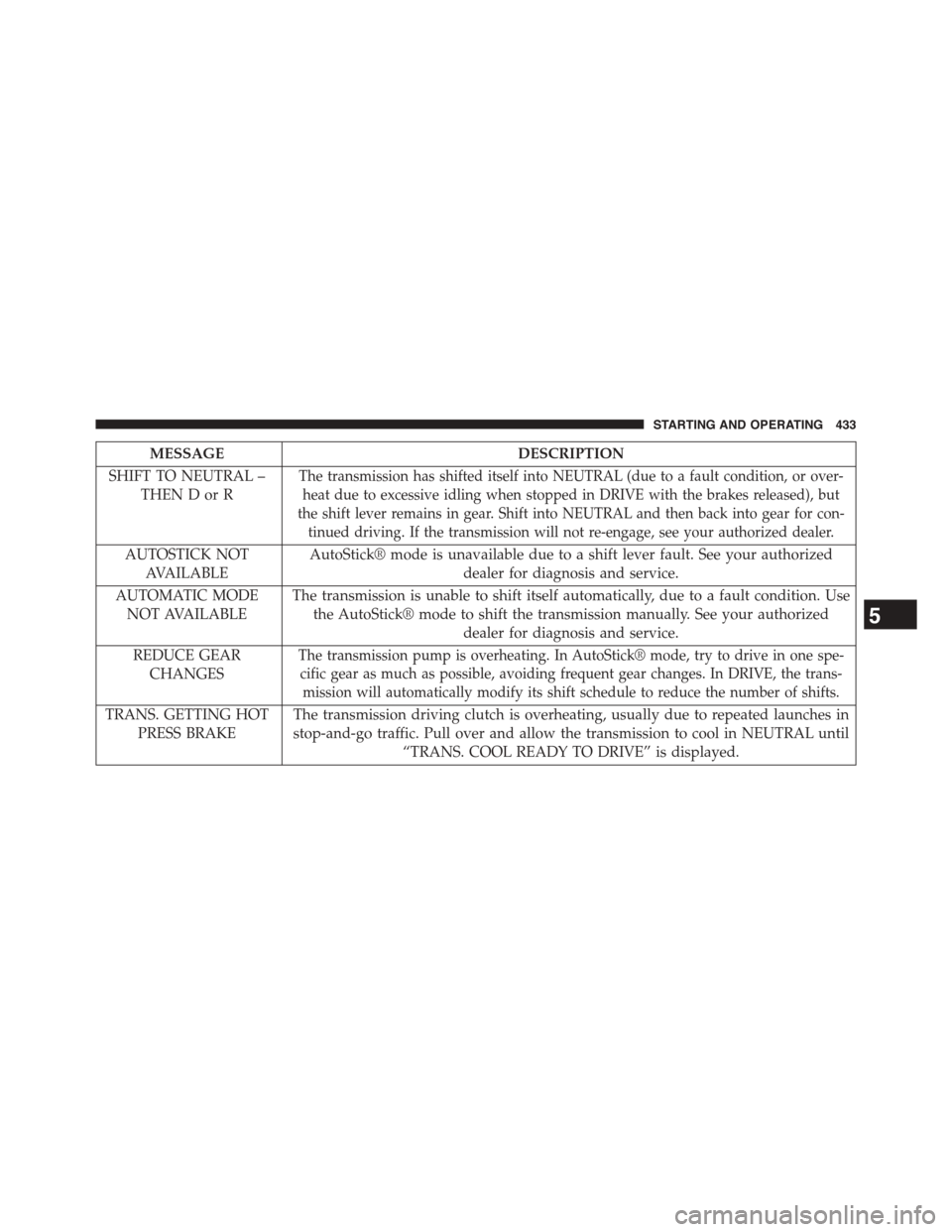
MESSAGEDESCRIPTION
SHIFT TO NEUTRAL –
THEN D or R
The transmission has shifted itself into NEUTRAL (due to a fault condition, or over-
heat due to excessive idling when stopped in DRIVE with the brakes released), but
the shift lever remains in gear. Shift into NEUTRAL and then back into gear for con-
tinued driving. If the transmission will not re-engage, see your authorized dealer.
AUTOSTICK NOT
AVAILABLE
AutoStick® mode is unavailable due to a shift lever fault. See your authorized
dealer for diagnosis and service.
AUTOMATIC MODE
NOT AVAILABLE
The transmission is unable to shift itself automatically, due to a fault condition. Use
the AutoStick® mode to shift the transmission manually. See your authorized
dealer for diagnosis and service.
REDUCE GEAR
CHANGES
The transmission pump is overheating. In AutoStick® mode, try to drive in one spe-
cific gear as much as possible, avoiding frequent gear changes. In DRIVE, the trans-
mission will automatically modify its shift schedule to reduce the number of shifts.
TRANS. GETTING HOT
PRESS BRAKE
The transmission driving clutch is overheating, usually due to repeated launches in
stop-and-go traffic. Pull over and allow the transmission to cool in NEUTRAL until
“TRANS. COOL READY TO DRIVE” is displayed.
5
STARTING AND OPERATING 433
Page 436 of 664
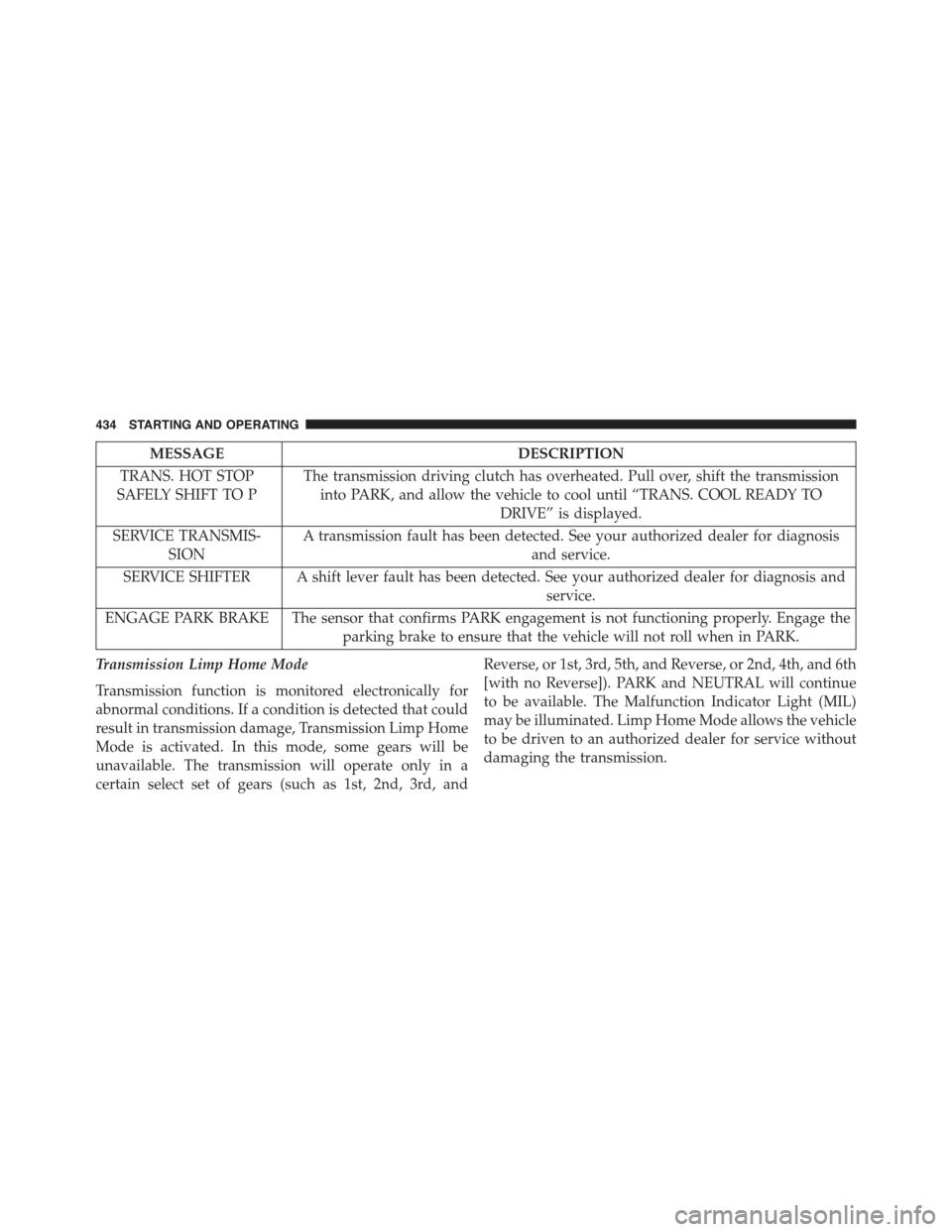
MESSAGEDESCRIPTION
TRANS. HOT STOP
SAFELY SHIFT TO P
The transmission driving clutch has overheated. Pull over, shift the transmission
into PARK, and allow the vehicle to cool until “TRANS. COOL READY TO
DRIVE” is displayed.
SERVICE TRANSMIS-
SION
A transmission fault has been detected. See your authorized dealer for diagnosis
and service.
SERVICE SHIFTER A shift lever fault has been detected. See your authorized dealer for diagnosis and
service.
ENGAGE PARK BRAKE The sensor that confirms PARK engagement is not functioning properly. Engage the
parking brake to ensure that the vehicle will not roll when in PARK.
Transmission Limp Home Mode
Transmission function is monitored electronically for
abnormal conditions. If a condition is detected that could
result in transmission damage, Transmission Limp Home
Mode is activated. In this mode, some gears will be
unavailable. The transmission will operate only in a
certain select set of gears (such as 1st, 2nd, 3rd, and
Reverse, or 1st, 3rd, 5th, and Reverse, or 2nd, 4th, and 6th
[with no Reverse]). PARK and NEUTRAL will continue
to be available. The Malfunction Indicator Light (MIL)
may be illuminated. Limp Home Mode allows the vehicle
to be driven to an authorized dealer for service without
damaging the transmission.
434 STARTING AND OPERATING
Page 443 of 664
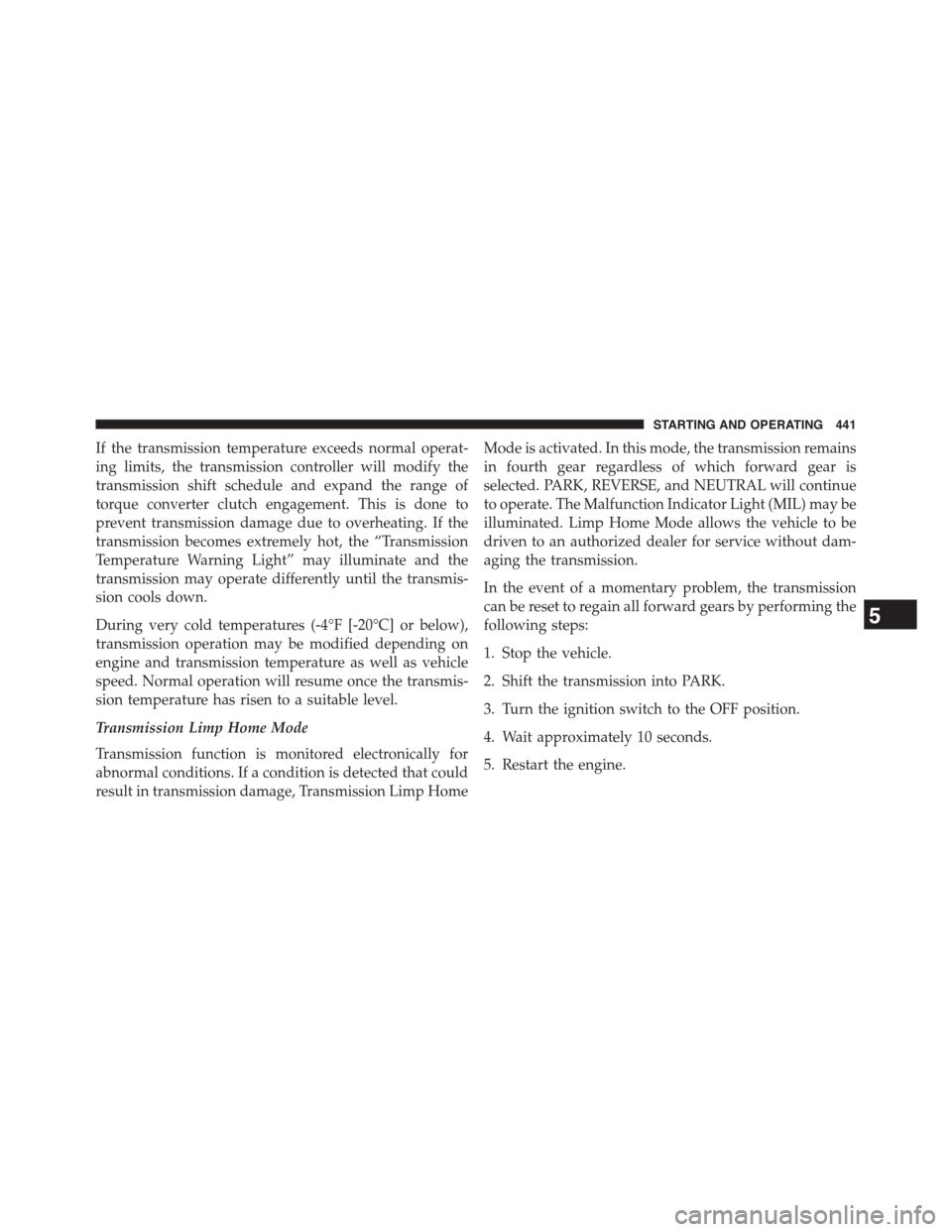
If the transmission temperature exceeds normal operat-
ing limits, the transmission controller will modify the
transmission shift schedule and expand the range of
torque converter clutch engagement. This is done to
prevent transmission damage due to overheating. If the
transmission becomes extremely hot, the “Transmission
Temperature Warning Light” may illuminate and the
transmission may operate differently until the transmis-
sion cools down.
During very cold temperatures (-4°F [-20°C] or below),
transmission operation may be modified depending on
engine and transmission temperature as well as vehicle
speed. Normal operation will resume once the transmis-
sion temperature has risen to a suitable level.
Transmission Limp Home Mode
Transmission function is monitored electronically for
abnormal conditions. If a condition is detected that could
result in transmission damage, Transmission Limp Home
Mode is activated. In this mode, the transmission remains
in fourth gear regardless of which forward gear is
selected. PARK, REVERSE, and NEUTRAL will continue
to operate. The Malfunction Indicator Light (MIL) may be
illuminated. Limp Home Mode allows the vehicle to be
driven to an authorized dealer for service without dam-
aging the transmission.
In the event of a momentary problem, the transmission
can be reset to regain all forward gears by performing the
following steps:
1. Stop the vehicle.
2. Shift the transmission into PARK.
3. Turn the ignition switch to the OFF position.
4. Wait approximately 10 seconds.
5. Restart the engine.
5
STARTING AND OPERATING 441